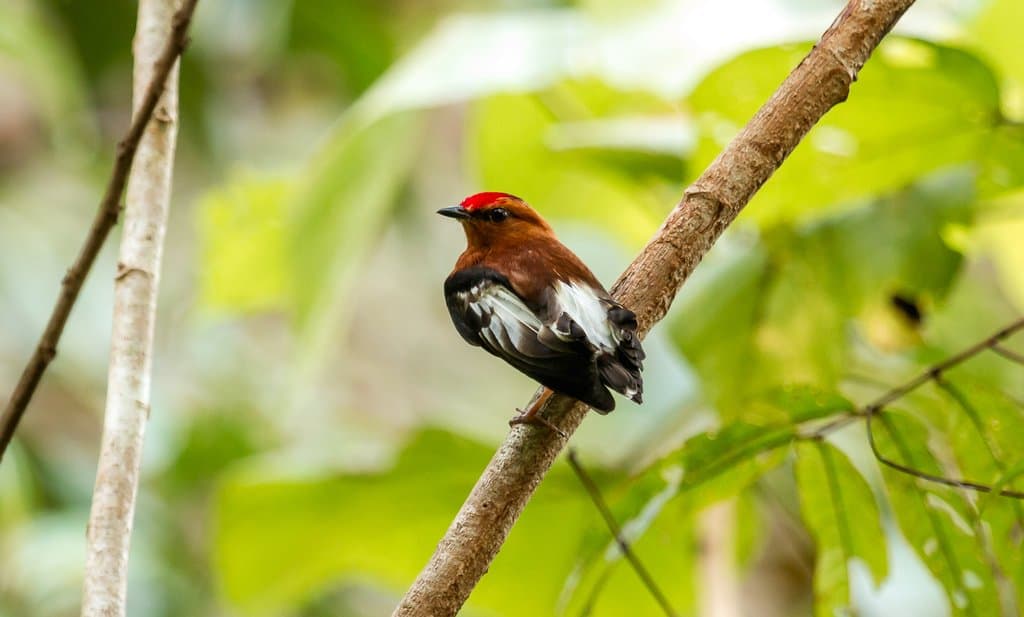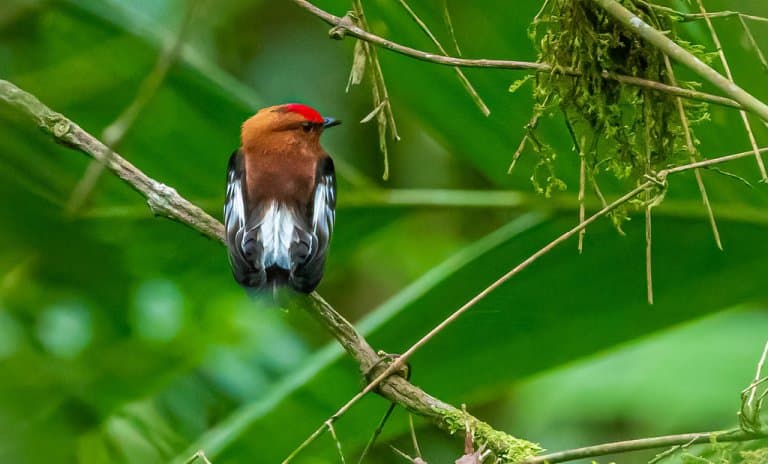Club-Winged Manakin Profile
The manakins are far from the stiff-limbed ornaments in shop windows their name suggests. They’re crafty little fashionistas, with delicate displays of intense colour and movement.
Among them, one species has taken its art form to a new level. Able to produce an eerily-detailed tone from the motion of its wings, it’s the only known bird to have discovered this skill.
The club-winged manakin is a small species of perching bird that lives in the western Andes Mountains of Colombia, and Ecuador.

Club-Winged Manakin Facts Overview
| Habitat: | Montane forest with abundant moss coverage |
| Location: | The Western Andes of Colombia and Ecuador |
| Lifespan: | 10-12 years |
| Size: | Around 10cm in length |
| Weight: | 0.7 oz (19.8 g) |
| Color: | Males are chestnut, with a red crown and black and white wings; females are olive brown |
| Diet: | Fruits and insects |
| Predators: | Unknown |
| Top Speed: | Unknown |
| No. of Species: |
1 |
| Conservation Status: |
Least Concern |
They inhabit the cloud forests and woods on the Western slopes of the Andes and spend their time eating berries, fruits and the occassional insect. But not much is known about the club-winged manakin’s behaviours outside of its infamous mating ritual.
It has some curious quirks to its physiology that allow it to produce its unique sound, and these seem to be an otherwise limiting attribute to the bird itself.
Club-winged manakins are a great example of the battle between sexual and natural selection, and the power of female birds to isolate and select for seemingly arbitrary idiosyncrasies in their mates.
For its conservation status, the club-winged manakin is categorised as a species of least concern. Recent research and trends, however, indicate that the population appears to be declining as a result of a slow loss of habitat.
Interesting Club-Winged Manakin Facts
1. They are delicate, (probably) not delicious
Despite what it looks like, this bird isn’t named for its flavour. It’s actually way cooler than that. The genus Machaeropterus comes from the Greek words for knife and wing.
The species name ‘deliciosus’ is Latin and means delicate. So, these cute little birds are delicate knife wings!
Please don’t try to eat them.

2. They ‘sing’ with their wings
These knife wings are more than just a cool gang name for the birds, they contribute to a unique quality that the manakins possess. By vibrating its wing over 100 times per second, it can create 1,400 single notes, combining in a loud and harmonious sound, similar to a violin or bleep.
This efffect is known as ‘sonation’, where a bird is able to produce sounds by other means than their syrinx. Other birds may use their bills, tail, feet or tools.
These wings have evolved to be particularly rigid, and, unlike the hollow bones of other flying birds, are solid. This is an adaptive trait that sacrifices some of its flight capacity for a quality that has been sexually selected as preferable.
To put it simply, the female of this species prefers musicians to pilots, and the club-winged manakin is one of the strangest musicians in the bird world, able to beat its wings twice as fast as a hummingbird and to sing with them!
3. Ticks and tings
Wing sounds are variable, and are commonly used to replace a vocal repertoire in a mating ritual.
These are the only birds known to use wing vibrations as an acoustic device; this is something more commonly found in other animal lineages, like insects than in vertebrates.
The sound comes along with a vivid wing display, involving flicking, flipping and flashing. Flicking the wing produces a tick sound while flipping them seems to create a metallic ting. These are followed by a vivid flash of colour.
To make a tick or a ting, he extends his legs and sticks his butt into the air. For ticks, the wings are then flicked up rapidly; for elongated tings, the wings are rotated in 0.017s and secondary feathers are flung upwards and over the back.
Specific feathers shiver and oscillate to create the sound, which is produced from these vibrations alone – the wings never touch one another!
4. They dance, too
This tiny musician also demonstrates a high level of skill in dancing, and even the wing flashes he supplements his song with have an artistic intricacy to them.
When the manakin is perched on a horizontal branch, he’ll bow forward with his neck extended and hop backwards, switching stances rapidly as with each little jump.
As he does, he’ll flutter his wings quietly, showing his vivid black and white markings, after which he’ll jerk his body from one side to the other, displaying the marks on his flanks. All of this happens within a period of about five seconds! 1

5. They perform jump turns
Aside from the little hops mentioned, they are seen leaping into the air, spinning 180° and landing back on the branch. These jump turns set the animal back down about 15cm along the branch and is accompanied by a soft tick.
They seem to like doing this between wing flashes, and while perched alone. In some instances, they will ignore the spin and leap sideways, twice as far, down the length of the branch. It seems like the length and duration of these jumps might relate to the health and vigour of the bird, suggesting its suitability as a strong mate.
These long jumps aren’t as frequent as the jump turns, and are probably harder to pull off.
6. They have some artistic disabilities
We mentioned a little about the bones of these birds, but it’s worth going into more detail about how they work. Most vertebrates have hollow, marrow-filled bones in their arms and legs. Most birds take this a little further and use air-filled pockets in their wing bones to make them even lighter for flight.
Male club-winged manakins have wing bones that are three times as dense as similar-sized birds. This makes them substantially heavier, and therefore harder to fly with, but supports the unique wing feathers that give them their name. 2
7. A confounding evolutionary variable
This is a sexually-selected trait, meaning that females have chosen a feature in the males that is apparently very costly to the animal.
And this is what makes the club-winged manakin such a curious example of evolution and a great demonstration of the differences between sexual and natural selection. In some cases, these two evolutionary drives are aligned, and mates will be chosen based on attributes that suggest their fitness for the environment.
In other cases, like this, and like the peacock’s enormous tail, a sexually-selected trait is an environmental handicap, yet it’s so popular, that the individual with the trait mates enough to pass it on before the handicap takes them out of the gene pool.
Evolution isn’t perfect; it’s a series of spontaneous genetic experiments that may or may not work.
Each mutation comes about at random, and the vast majority don’t help at all. Every now and then, one will benefit the animal and they’ll have more reproductive success. Then, that mutation is passed on to others, and another link in the evolutionary chain is formed. 3

Club-Winged Manakin Fact-File Summary
Scientific Classification
| Kingdom: | Animalia |
| Phylum: | Chordata |
| Class: | Aves |
| Order: | Passeriformes |
| Family: | Pipridae |
| Genus: | Machaeropterus |
| Species Name: |
Machaeropterus Deliciosus |
Fact Sources & References
- Kimberly S. Bostwick (2000), “Display Behaviors, Mechanical Sounds, and Evolutionary Relationships of The Club-Winged Manakin (Machaeropterus Deliciosus)“, The Auk, Volume 117.
- Kimberly S. Bostwick, Mark L. Riccio and Julian M. Humphries (2012), “Massive, solidified bone in the wing of a volant courting bird“, Biology Letters.
- Kim Bostwick, “How boogieing birds evolved“, Understanding Evolution.
